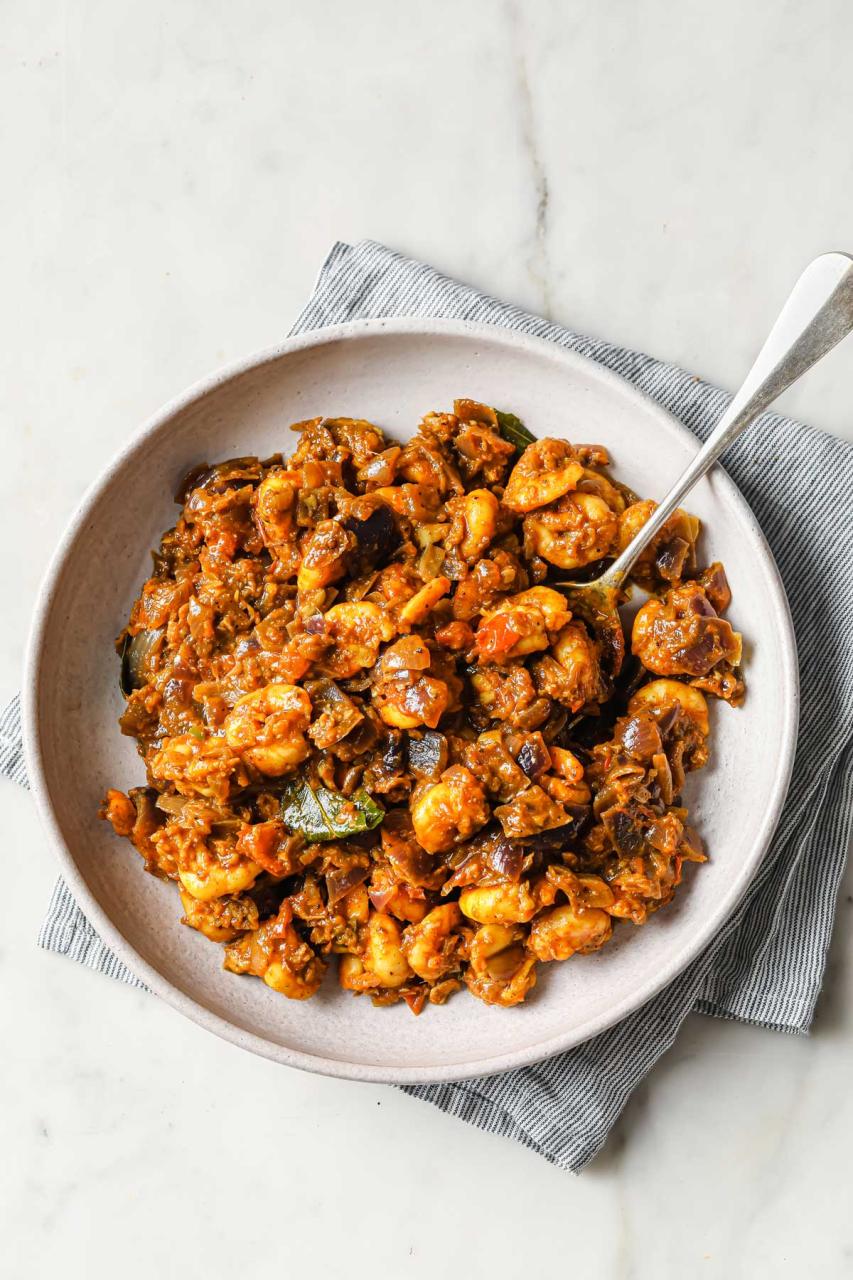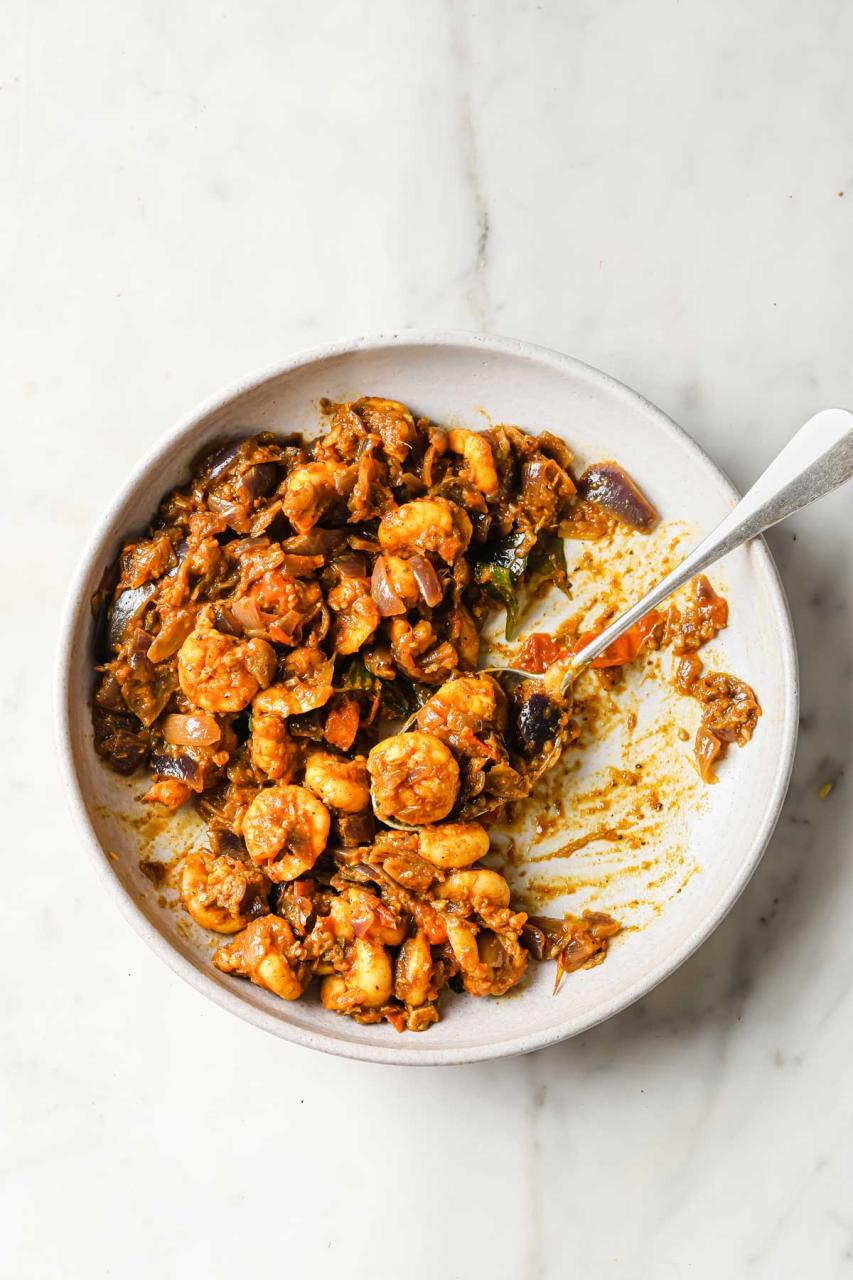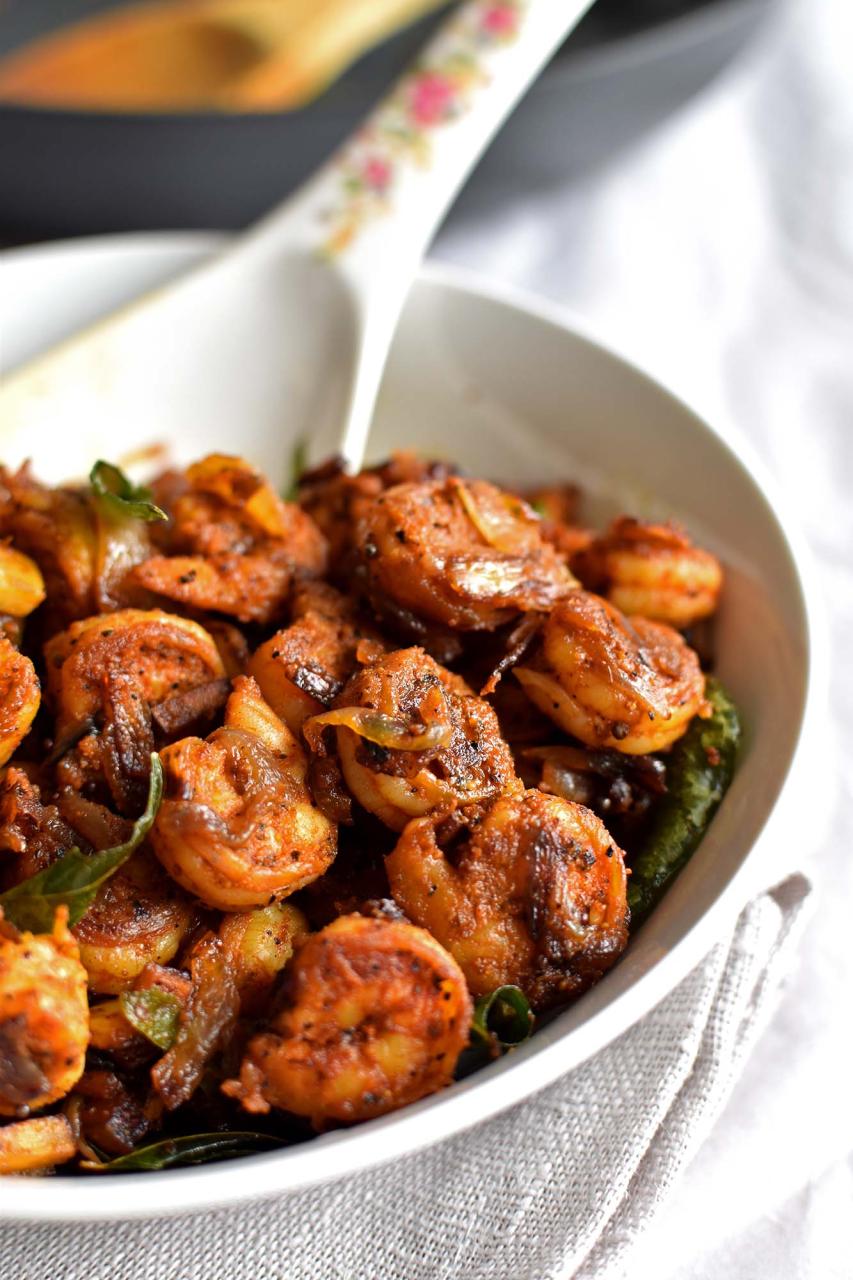Kerala-Style Prawn Masala Roast is a delectable dish that captures the essence of Kerala’s celebrated spice heritage and its love affair with seafood. Known for its lush landscapes and extensive coastlines, Kerala offers an abundance of fresh seafood which forms a significant part of its cuisine.
This dish blends the sweetness of prawns with an array of earthy spices such as black mustard seeds, fenugreek, turmeric, chili powder, and, notably, black pepper, for which Kerala is famous worldwide. The prawns are marinated briefly then roasted in a masala made from sautéed onions, garlic, ginger, tomatoes, and green chilies. What sets this roast apart is the thick, rich gravy that coats the prawns, developed by simmering and reduced until oil surfaces on top.
The flavor profile is further enhanced with the use of curry leaves, adding a characteristic aroma, and tamarind paste or ‘kudampuli’ (Kerala’s black tamarind), which gives a subtle tartness to complement the spices. A finishing touch of coconut oil is sometimes added at the end of cooking, lending an authentic Keralan flavor that elevates the dish.
Kerala-Style Prawn Masala Roast recipe


Kerala-Style Prawn Masala Roast
Equipment
- 1 blender
- 1 large skillet
Ingredients
- 2 onions chopped, divided
- 1 1/2-inch piece fresh ginger, peeled
- 1 curry leaf sprig
- 1 green chile stemmed and seeded
- 1 tablespoon coconut oil
- 1/2 teaspoon mustard seeds
- 1/2 teaspoon fennel seeds
- 1/4 teaspoon fenugreek seeds
- 2 garlic cloves minced
- 1 to 2 teaspoons red chile powder
- 1/2 teaspoon ground coriander
- 1/2 teaspoon freshly ground black pepper
- 1/4 teaspoon ground turmeric
- Salt
- 1 pound shrimp peeled and deveined
- 1 teaspoon garam masala
- Chopped fresh cilantro for garnish
Instructions
- In a blender, combine half the onion, the ginger, curry leaves, and green chile and process until smooth. Set aside.
- In a large skillet over medium-high heat, heat the coconut oil.
- Add the mustard seeds and cook until they begin to sputter, about 1 minute.
- Stir in the fennel seeds and fenugreek seeds. Add the puréed mixture to the skillet and cook for about 1 minute, stirring constantly.
- Add the remaining chopped onion and the garlic. Cook for 4 to 5 minutes, stirring frequently, until the onion is translucent.
- Add the chile powder, coriander, pepper, and turmeric. Season with salt and stir.
- Add the shrimp to the skillet and stir to combine. Cover the skillet and reduce the heat to low. Cook for 5 to 7 minutes until the shrimp are opaque and cooked through.
- Remove the lid and stir in the garam masala. Top with cilantro for serving.
Notes
Cooking Tips about Kerala-Style Prawn Masala Roast

- Selecting Prawns: Choose fresh, high-quality prawns for this dish. They should be cleaned, deveined, and tails intact for presentation if desired.
- Marination: Briefly marinate the prawns in a mixture of spices like turmeric, chili powder, and black pepper to give them an initial layer of flavor. A dash of lemon juice can also be added for some zest.
- Use of Spices: Key spices such as mustard seeds, fenugreek, freshly cracked black pepper, and curry leaves are essential for achieving the distinctive taste of this dish. Kerala’s famous black pepper adds a robust flavor that’s not overpowering.
- Cooking Oil: Coconut oil is preferred in Kerala cuisine for its authentic taste. It imparts a subtle coconut flavor to the dish, enhancing the overall profile.
- Making the Masala Base: The masala roast requires a good base, which means slowly sautéing onions, ginger, and garlic until golden, followed by tomatoes and green chilies until the oil starts to separate from the mix.
- Simmering: When the prawns are added to the masala, ensure they’re well-coated and let them cook on a low flame. Prawns cook quickly, so keep an eye out to prevent overcooking, which could make them rubbery.
- Consistency of the Gravy: This dish is known for its thick masala that clings to the prawns. Simmer the masala until it reduces and becomes rich in color, indicating the flavors have concentrated.
- Use of Tamarind: A bit of tamarind paste or ‘kudampuli’ (black tamarind) contributes the characteristic tanginess of Kerala dishes. It balances the richness of the spices.
- Finishing Touch: Often, a drizzle of coconut oil is added just before taking the dish off the heat to enhance the aroma and add additional flavor layers.
- Resting Time: Allow the dish to rest for a few minutes after cooking. This lets the prawns absorb the flavors from the masala roast even more deeply.
Serving suggestions about Kerala-Style Prawn Masala Roast

- Kerala Matta Rice: Also known as red rice, this variety is revered in Kerala and its earthy flavor pairs nicely with the robust prawn masala roast.
- Appam: These light, fluffy pancakes with a thin crispy edge and soft center are perfect for dipping into the thick masala and absorb all the delicious flavors.
- Parotta: A flaky, layered flatbread from Kerala, often served with meat dishes, can be torn apart and used to scoop up the prawn masala.
- Steamed Idiyappam: The string-like rice noodles, also known as nool puttu, are a delicate choice that complements the spiciness of the prawn roast exceptionally well.
- Dosa: Crispy dosas can serve as a suitable alternative to scoop up the masala and add a contrasting texture to the tender prawns.
- Simple Side Salad: A simple side salad such as thinly sliced cucumber and onion with a light dressing can provide a refreshing contrast to the richness of the prawn masala.
- Lime or Lemon Wedges: A squeeze of lime or lemon just before eating can elevate the tanginess and freshness of the seafood.
- Pickle: A small portion of tangy and spicy Kerala-style pickle, such as mango or lime, can make a zesty side to accompany the meal.
Top 5 FAQs about Kerala-Style Prawn Masala Roast

- What makes Kerala-Style Prawn Masala Roast unique? The uniqueness of Kerala-Style Prawn Masala Roast comes from its use of earthy spices such as black mustard seeds, fenugreek, turmeric, chili powder, and particularly black pepper which is renowned in Kerala. Additionally, the dish also includes the distinct flavors of curry leaves and tamarind, along with a rich, thick gravy that coats the prawns.
- Can I use frozen prawns for this dish? Yes, you can use frozen prawns, but make sure they are thoroughly defrosted and patted dry before marination. Fresh, high-quality prawns are preferred, cleaned, deveined, and with tails intact if desired for presentation.
- How spicy is Kerala-Style Prawn Masala Roast? The spice level of Kerala-Style Prawn Masala Roast can vary according to taste but traditionally features a robust flavor from black pepper without being too overpowering. Green chilies and chili powder add to the heat, which can be adjusted to suit personal preferences.
- What should I serve with Kerala-Style Prawn Masala Roast? It is typically served as a main course paired with Kerala Matta Rice, appam, parotta, steamed idiyappam, dosa, or a simple side salad. A squeeze of lime or lemon just before eating can enhance the flavor.
- Is it necessary to use coconut oil in the recipe? While coconut oil is recommended due to its authentic Kerala flavor, other cooking oils can be used if coconut oil is not available. However, using coconut oil can significantly enhance the taste by imparting a subtle coconut aroma and flavor to the dish.
In conclusion, the Kerala-Style Prawn Masala Roast is a sumptuous reflection of the coastal state’s affinity for intricately flavored seafood preparations. The dish marries the natural succulence of prawns with a potent blend of local spices, including the globally acclaimed Kerala black pepper and other earthy ingredients such as mustard seeds, fenugreek, turmeric, and chili.

Leave a Reply